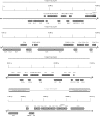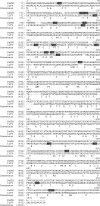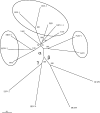Psittacid herpesvirus 1 and infectious laryngotracheitis virus: Comparative genome sequence analysis of two avian alphaherpesviruses
- PMID: 16873243
- PMCID: PMC1563825
- DOI: 10.1128/JVI.00134-06
Psittacid herpesvirus 1 and infectious laryngotracheitis virus: Comparative genome sequence analysis of two avian alphaherpesviruses
Abstract
Psittacid herpesvirus 1 (PsHV-1) is the causative agent of Pacheco's disease, an acute, highly contagious, and potentially lethal respiratory herpesvirus infection in psittacine birds, while infectious laryngotracheitis virus (ILTV) is a highly contagious and economically significant avian herpesvirus which is responsible for an acute respiratory disease limited to galliform birds. The complete genome sequence of PsHV-1 has been determined and compared to the ILTV sequence, assembled from published data. The PsHV-1 and ILTV genomes exhibit similar structural characteristics and are 163,025 bp and 148,665 bp in length, respectively. The PsHV-1 genome contains 73 predicted open reading frames (ORFs), while the ILTV genome contains 77 predicted ORFs. Both genomes contain an inversion in the unique long region similar to that observed in pseudorabies virus. PsHV-1 is closely related to ILTV, and it is proposed that it be assigned to the Iltovirus genus. These two avian herpesviruses represent a phylogenetically unique clade of alphaherpesviruses that are distinct from the Marek's disease-like viruses (Mardivirus). The determination of the complete genomic nucleotide sequences of PsHV-1 and ILTV provides a tool for further comparative and functional analysis of this unique class of avian alphaherpesviruses.
Figures





Similar articles
-
Gene arrangement within the unique long genome region of infectious laryngotracheitis virus is distinct from that of other alphaherpesviruses.J Virol. 1998 Jan;72(1):847-52. doi: 10.1128/JVI.72.1.847-852.1998. J Virol. 1998. PMID: 9420298 Free PMC article.
-
DNA sequence and transcriptional analysis of the UL1 to UL5 gene cluster of infectious laryngotracheitis virus.J Gen Virol. 1996 Sep;77 ( Pt 9):2221-9. doi: 10.1099/0022-1317-77-9-2221. J Gen Virol. 1996. PMID: 8811022
-
Molecular evolution of infectious laryngotracheitis virus (ILTV; gallid herpesvirus 1): an ancient example of the Alphaherpesviridae?Vet Microbiol. 1995 Sep;46(1-3):221-31. doi: 10.1016/0378-1135(95)00086-p. Vet Microbiol. 1995. PMID: 8545960
-
A novel herpesvirus associated with respiratory disease in Bourke's parrots (Neopsephotus bourkii).Avian Pathol. 2012 Dec;41(6):531-9. doi: 10.1080/03079457.2012.732692. Avian Pathol. 2012. PMID: 23237365 Review.
-
Molecular biology of avian infectious laryngotracheitis virus.Vet Res. 2007 Mar-Apr;38(2):261-79. doi: 10.1051/vetres:200657. Epub 2007 Feb 13. Vet Res. 2007. PMID: 17296156 Review.
Cited by
-
Multiple Comparison Analysis of Two New Genomic Sequences of ILTV Strains from China with Other Strains from Different Geographic Regions.PLoS One. 2015 Jul 17;10(7):e0132747. doi: 10.1371/journal.pone.0132747. eCollection 2015. PLoS One. 2015. PMID: 26186451 Free PMC article.
-
A novel herpesvirus in 3 species of pheasants: mountain peacock pheasant (Polyplectron inopinatum), Malayan peacock pheasant (Polyplectron malacense), and Congo peafowl (Afropavo congensis).Vet Pathol. 2012 May;49(3):482-91. doi: 10.1177/0300985811424733. Epub 2011 Nov 10. Vet Pathol. 2012. PMID: 22075776 Free PMC article.
-
Genotypic characterization of psittacid herpesvirus isolates from Brazil.Braz J Microbiol. 2016 Jan-Mar;47(1):217-24. doi: 10.1016/j.bjm.2015.11.017. Epub 2016 Jan 27. Braz J Microbiol. 2016. PMID: 26887248 Free PMC article.
-
Molecular detection and genetic characterization of infectious laryngotracheitis virus in poultry in Myanmar.BMC Vet Res. 2020 Nov 23;16(1):453. doi: 10.1186/s12917-020-02666-z. BMC Vet Res. 2020. PMID: 33228640 Free PMC article.
-
Herpesviruses: overview of systematics, genomic complexity and life cycle.Virol J. 2025 May 22;22(1):155. doi: 10.1186/s12985-025-02779-7. Virol J. 2025. PMID: 40399963 Free PMC article. Review.
References
-
- Aini, L., L. M. Shih, A. E. Castro, and Y. X. Zee. 1993. Comparison of herpesvirus isolates from falcons, pigeons, and psittacines by restriction endonuclease analysis. J. Wildlife Dis. 29:196-202. - PubMed
-
- Altschul, S. F., W. Gish, W. Miller, E. W. Myers, and D. J. Lipman. 1990. Basic local alignment search tool. J. Mol. Biol. 215:403-410. - PubMed
Publication types
MeSH terms
LinkOut - more resources
Full Text Sources
Other Literature Sources

